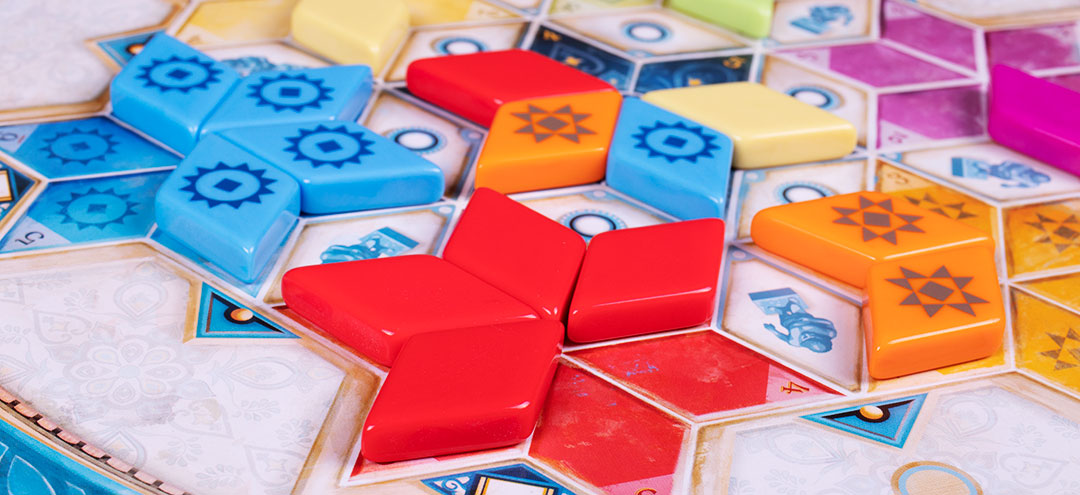 3 years ago, Next Move Games released a surprise hit in their abstract strategy game Azul. You can read Andrews’s review of it here if you want the ins and outs, but overall I found it to be an entertaining and accessible game that I still play fairly regularly. Azul was followed up in 2018 with Azul: Sainted Glass of Sintra. This added a few more wrinkles to the Azul formula, but I walked away from this one being less than impressed and have not had a desire to return to it since.
3 years ago, Next Move Games released a surprise hit in their abstract strategy game Azul. You can read Andrews’s review of it here if you want the ins and outs, but overall I found it to be an entertaining and accessible game that I still play fairly regularly. Azul was followed up in 2018 with Azul: Sainted Glass of Sintra. This added a few more wrinkles to the Azul formula, but I walked away from this one being less than impressed and have not had a desire to return to it since.
This year, Designer Michael Kiesling has once again gone back to the tile factory and brought us Azul: Summer Pavilion. Does the formula hold up after a third iteration? Time to find out.
Gameplay Overview:
If you’ve played an Azul game before, you’ll feel right at home with the core mechanics of the game. For new players, here is a quick overview. The game is divided into 6 rounds with each round having three phases.
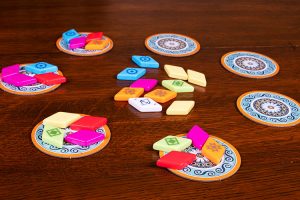
In the acquire tiles phase, players will take turns drafting tiles from either one of the factories or the center of the table. A player may take all similar colored tiles from one factory and also 1 wild tile. The rest of the tiles are sent to the middle of the table. Players drafting from the middle of the table use the same rules (other than moving unchosen tiles) with the only wrinkle being the first player to draft a tile from the middle of the table loses a point for each tile drafted, but also claims the first player token.
Once all tiles are drafted, players move on to the play tiles phase. In turn order, players place tiles onto their boards with each color going into a specific section. The number on the spot indicates how many tiles must be spent to place a tile there (so 3 tiles in the #3 spot). Wild tiles can be used as long as at least one of the matching color tiles was also played. They the player will score a point for the tile they placed and each adjacent tile. If a player manages to surround one of the bonus spots (pillars, statues, or windows) with tiles, they can claim a tile(s) from the center display.
After all tiles have been played and a cleanup phase is complete, a new round begins. Players may also save up to 4 tiles from round to round. The game ends after the 6th round with a few bonus scoring objectives. The player with the most points wins.
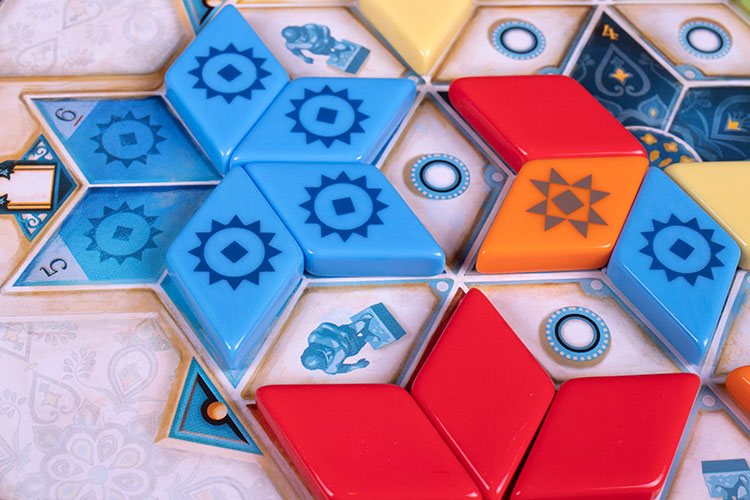
Game Experience:
I wasn’t sure what to expect from Azul: Summer Pavilion. Azul was a sneaky hit for me, but Stained Glass of Sintra ended up being a dud. However I think Summer Pavilion might just be my favorite Azul yet. One reason is that the game really rewards forward thinking, definitely more so than previous iterations of the game.
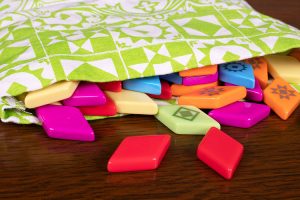
This is due to the changing wild color each round. Players can look ahead on the round track and see what the upcoming wild color will be. And since you can save tiles between rounds, you can even bank some potential wild tokens for upcoming rounds. The other way it rewards strategic thinking is with the bonus pillar, statue, and window spaces. If you can activate those at the right time, you can collect some nice bonus tiles to help move you along. You’ll never be able to get all of them, but the right one at the right time is certainly helpful.
Azul: Summer Pavilion also gives players flexibility on how they want to formulate their strategy. The end game scoring awards points for having numbers covered up (all 2s for example) and also for fully filling in a color. That means players will need to decide if they spread out their choices among all the colors to capture the numbers or concentrate on one color to get the bonus for that. Rarely will a player have enough time to do both—at least not to a high degree.
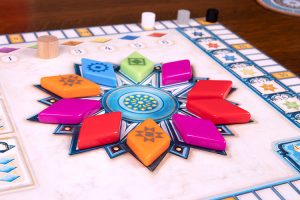
I’ve also noticed that this iteration of Azul is much nicer than its predecessors. Since you can keep up to four tiles between rounds, it’s somewhat rare to lose points from leftover tiles. The only time you have to worry about that is at the end of the game where leftover tiles lose you a point. I suppose this can be considered a negative for players that enjoyed the hate drafting aspect of the original Azul.
Speaking of negatives, one thing I really didn’t care for was the score tracker. Overall the components in summer Pavilion are really good, but the score tracker is flimsy and it’s way too easy to knock someone’s score cube off their space. Since you will be reaching to that sheet to claim your bonus tiles, this wasn’t the best place to put the score track. There also doesn’t seem to be a great spot to put the sheet where everyone can reach it.
Final Thoughts:
Whether it’s from a refinement of the concept or just hitting the sweet spot for me, I think Azul: Summer Pavilion is my favorite version of Azul yet. I have enjoyed each play and have been able to bring this one out with a diverse group of people. The rules are easy enough that even non-gamers seem to be able to pick it up. Does the Azul formula have room for additional versions? Time will tell on that one. But so far, Michael Kiesling is managing to pull it off. Do you need all three versions of Azul in your collection?. Probably not unless you are the most diehard of fans. If you think you will mostly play with casual friends or your family, Azul: Summer Pavilion would definitely be the one to get.
Final score: 4 Stars – A great abstract strategy game that takes the Azul formula and makes it a bit more strategic while removing a bit of the meanness.
 Hits:
Hits:
• Nice strategic gameplay
• Colorful tiles are fun to play with
• Less mean than previous iterations
• Flexibitiy in strategy
Misses:
• Score track is kind of sucky compared to the rest of the components







